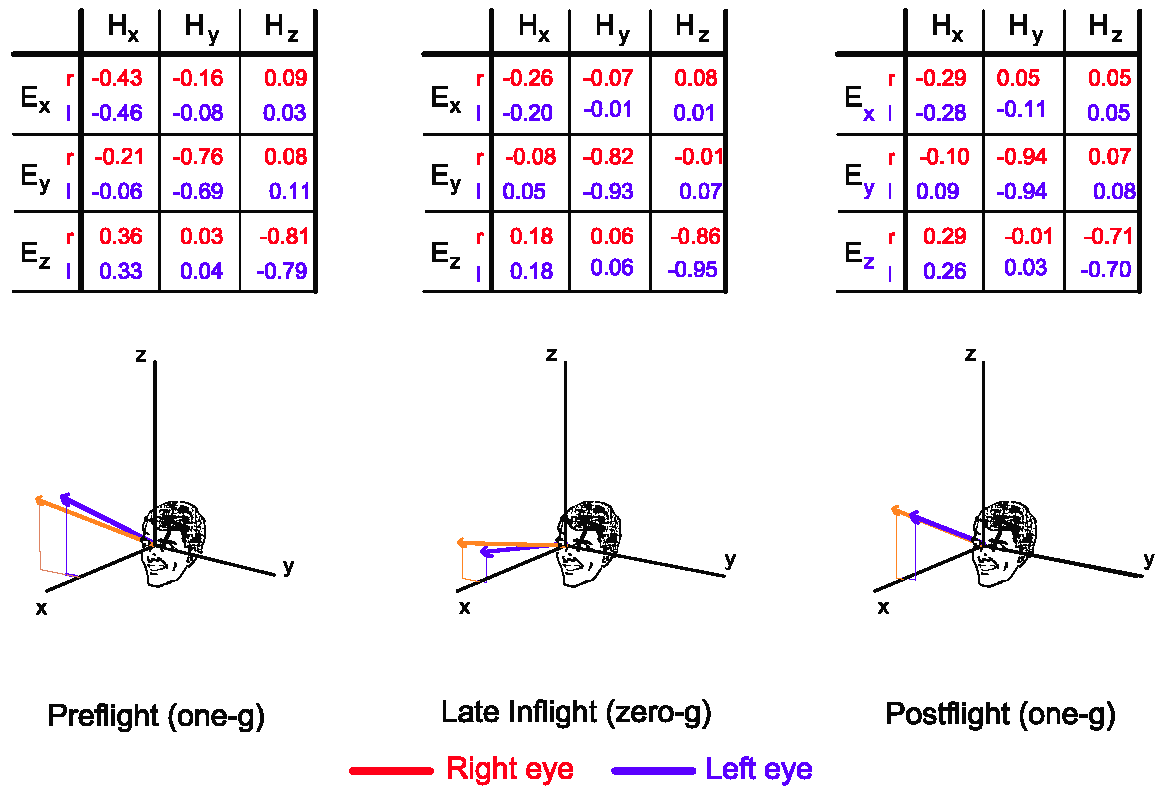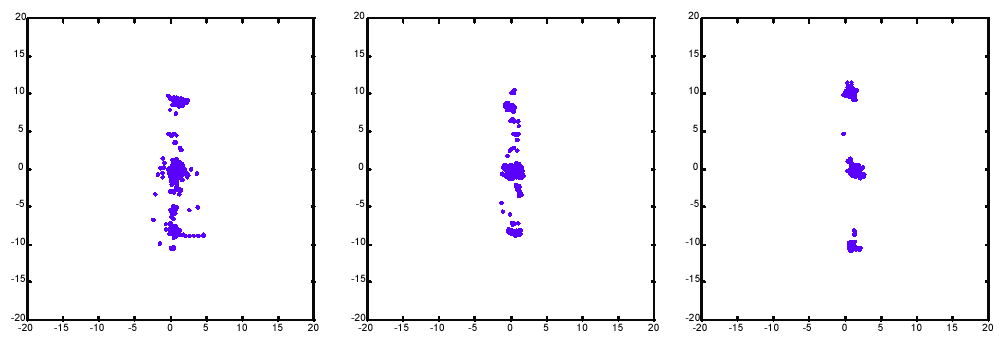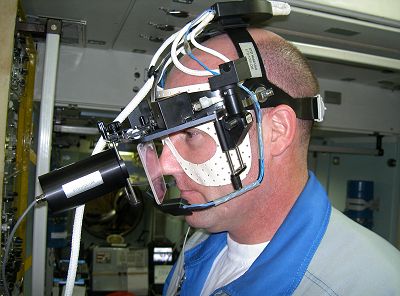
|
OLP
|

|
Abstract: The purpose of the experiment is to evaluate the orientation of Listing's plane under different gravity conditions and adaptation levels. Examination of the orientation of Listing's plane during the course of a prolonged microgravity mission is of particular interest, given the evidence that under one-g, Earthbound conditions it appears to be dependent on head position to gravity, i.e. dependent on otolithic input (Haslwanter et al, 1992; Hess & Angelaki, 1996). The question as to what extent the orientation of Listing's plane is altered by the vestibular adaptation to microgravity, or under hypergravic and hypogravic conditions, can be examined fairly simply, provided accurate three-dimensional eye-in-head measurements can be made. A corollary aspect is to what extent Listing's Plane is dissociated form the internal co-ordinate frame of reference of the vestibulo-oculomotor response (VOR) during prolonged microgravity. Under one-g condition the two have been shown to be collinear (Crawford et al, 1991), but preliminary findings in microgravity indicate that the VOR frame of reference is modified by the absence of otolithic loading, whereas Listing's Plane remains stable (Clarke et al, 1996). A further question is whether compensatory mechanisms substitute for the missing sensory input from the otolith organs during long-term spaceflight. Possible sensory information which could serve as compensatory input are neck afferents and vision. Accordingly, it is proposed to record Listing's plane with different static head tilts and with / without visual input.
Address corresponding
author:
Prof. Andrew H. Clarke, Vestibular Research Lab, Klinikum Benjamin Franklin,
Hindenburgdamm 30, D-12200 Berlin, FRG. Phone: (49 30) 798 2434, Fax: (49 30)
834 2116, Email: clarke@medizin.fu-berlin.de
Co-Investigators (all TNO-Human Factors):
Dr. T. Haslwanter, Dept. of Neurology, Universität Zurich, CH and Dr. Jelte
Bos, TNO, Human Factors, Soesterberg, NL.
Hardware Manufacturer: Kayser Threde, Munich, Germany.
Objectives: 1) To determine the influence of prolonged microgravity and the accompanying vestibular adaptation on the orientation of Listing’s Plane; 2) To determine whether Listing’s Plane as a measure of the coordinate frame of the visual system dissociates with that of the vestibular system.
Hypothesis:The working hypothesis is that in microgravity the orientation of Listing’s Plane is altered, probably to a small and individually variable degree. Further, with the loss of the otolith-mediated gravitational reference, it is expected that changes in the orientation of the coordinate framework of the vestibular system occur, and thus a divergence between Listing’s Plane and the vestibular coordinate frame should be observed. While earlier ground-based experiments (Haslwanter et al,1992, Böckisch & Haslwanter, 2001) indicate that Listing’s Plane itself is to a small degree dependent on the pitch orientation to gravity, there is more compelling evidence of an alteration of the orientation of the VOR in microgravity. The proposed experiment is intended to resolve these questions.
Methods: Listing’s Plane can be examined fairly simply, provided accurate three-dimensional eye-in-head measurements can be made. Identical experimental protocols will be performed during the pre-flight, inflight and postflight periods of the mission. Accurate three-dimensional eye-in-head measurements are essential to the success of this experiment. The required measurement specifications (< 0.1° spatial resolution, 200 Hz sampling frequency) are fulfilled by the Eye Tracking Device (ETD).
Previous experience: Previous experiments concerning SIC and SAS were conducted with the astronauts of the D1 Spacelab Mission, and of the EUROMIR’94 mission. Of the eight astro- and cosmonauts that participated in these experiments, the ones that were susceptible to SIC were also susceptible to SAS, and the ones that were not affected by the long duration centrifugation appeared to be unsusceptible to SAS. These results underscore our hypothesis, that there is a positive correlation between SIC and SAS. Long duration centrifugation experiments were also performed with many subjects without space experience (»40)
Purpose of Research: Why study eye movements in microgravity? Orientation and the perception of movement in three-dimensional space involves transduction of three degrees of freedom for angular rotation and three degrees of freedom for linear translation. In the vestibular system, this is provided for by the semicircular canals and the otolith organs, respectively. Via the vestibulo-ocular pathways in the brainstem, the afferents from the vestibular end organs are utilized synergistically for the purpose of gaze stabilization and are reflected by compensatory eye movements in the three orthogonal planes governed by the extraocular muscle pairs. Thus, any physiological stimulation to the vestibular receptors, either by rotatory, gravitational or translatory acceleration, or a combination thereof, will potentially elicit a systematic compensatory eye movement consisting of horizontal, vertical and/or torsional components, i.e. the three-dimensional VOR. For a full understanding of the vestibulo-oculomotor system, it is necessary to examine the three-dimensional processing of the afferent information from the semicircular canals and otolith organs and to determine their respective contributions to the elicitation of the compensatory reflex eye movements. Adequate measurement of the vestibulo-oculomotor response is arguable the most important inroad in the case of human experimentation. Inflight measurement of the binocular 3D-VOR was performed for the first time during the Euromir 95 mission. The results from one subject are summarised in Fig. 1..
 Fig 1. 3D velocity gain matrices and the corresponding minimal gain vectors for one subject tested during the preflight inflight and postflight periods. Data from three test sessions are averaged in each case. The modification of the VOR c-ordinate frame is reflected in the altered orientation of the minimal gain vectors (Clarke et al, 2000). |
Since the late 19th century (e.g. Helmholtz, 1866), it has been known that under normal visual conditions the torsional orientation of the eye is independent of the path that the eye takes to reach any secondary or tertiary eye position. This restriction implies a reduction from three to two degrees of freedom for the eyeball, and is known as Listing’s law; thus, all axes about which the eye rotates from the so-called primary position lie in one plane, called Listing’s Plane. Listing’s Plane can be visualised by plotting 3D eye positions as quaternions (Tweed & Vilis, 1987) or rotation vectors (Haustein, 1989). Recent investigations have verified the validity of Listing’s law during fixations, saccades and smooth pursuit (Straumann et al, 1996), and it has been argued recently that Listing’s Plane is primarily under visuomotor control (Hepp et al, 1997). However, under one-g conditions Listing’s Plane has been found to be dependent on the otolith-mediated gravitoinertial vector in the monkey (Haslwanter et al, 1992) and to a lesser extent in the human (Böckisch & Haslwanter, 2001). In a detailed analysis of vestibular fast phases, Hess & Angelaki (1996) demonstrated that the resulting displacement plane is dependent on head orientation to gravity. Corresponding to these changes in the orientation of Listing’s Plane, the subjective straight ahead direction of gaze (Citek & Ebenholtz, 1996) has been observed to change with static pitch and roll. An important question with regard to the neurophysiological substrate of spatial orientation is to what extent the co-ordinate frame of Listing’s Plane is collinear with that of the 3D VOR. This is of key importance for the hypothesised existence of a uniform representation of three-dimensional space across of those CNS areas related to spatial orientation (Cohen, 1988).
To what extent are the orientations
of Listing’s Plane and the 3D-VOR altered during and after exposure to prolonged
microgravity ?
The well-documented occurrence of ocular counterrolling (OCR) when the head
is tilted in one-g conditions (e.g. Diamond & Markham, 1983) is reflected in
the translation of Listing’s Plane along the x-axis of the head. As described
above, the orientation of Listing’s Plane is modified to some extent by changes
in head pitch and roll position (Haslwanter 1992, Böckisch & Haslwanter, 2001;
Hess and Angelaki,1997; Citek & Ebenholtz, 1996). In microgravity, recording
of the orientation of Listing’s Plane relative to the head should provide key
information on its dependence on the gravito-inertial vector, i.e. the otolith-mediated
vertical. Preliminary results from one subject tested during the Euromir 95
mission are shown in Fig. 2.
 Fig 2. First measurement of Listing’s Plane during the course of a spaceflight mission. The data were obtained from the same subject as in Fig. 1 during the preflight, inflight and postflight periods. The quaternion data from the calibration fixation sequences were employed for this purpose. The average tilt (X-Z Plane) was -1.8°, -2.1° and -2.3° respectively. These preliminary results indicate that Listing’s Plane remains constant during microgravity. (From Clarke et al, 1997). |
In microgravity, recording of the orientation of Listing’s Plane relative to the head should provide more information on its dependence on the gravito-inertial vector, respectively the otolith-mediated vertical. Preliminary results from one subject tested during the Euromir 95 mission are shown in Fig. 2. Binocular recordings will be made in order to explore further the indication that Listing’s Plane is both vergence dependent, and differs between dominant and non-dominant eye. The question as to whether the co-ordinate system of the VOR is collinear to the Listing's Plane has been examined in monkeys (Crawford and Vilis 1991) using the search-coil technique. They reported that Listing’s Plane remained collinear with the VOR co-ordinate system, as described by the minimal gain vector. Similar investigation of the orientation of the VOR coordinate system in humans during a longterm spaceflight mission (180 days) has indicated modification of the 3-D gain matrix during such prolonged microgravity (Clarke et al. 1996, 1997). The experiment is therefore directed at the question of the collinearity between the VOR and Listing coordinates. Finally, it should be determined to what extent cervical afferences or visual input substitute for the lack of a gravitational reference during adaptation to microgravity.
Research facilities used in these experiments: All measurement and evaluation of eye and head movements will be performed with the binocular, three-dimensional eye tracking device (ETD) scheduled for integration on the ISS (Clarke et al, 1999, 2000). The present science model is illustrated in Fig. 3. The performance of the ETD shall provide high resolution (<0.1°) and high sampling rate (200 Hz) measurement of 3D eye movement. Head rotation and translation will be recorded synchronously by means of the triaxial angular rate sensors and linear accelerometers integrated in the ETD Head Unit and included as part of the ETD data stream. All sensors are sampled at the selected ETD image rate. Relative movement of the Head Unit (slippage) shall be minimised by using customised biteboards, which lock the Head Unit to the upper denture.
 |
 |
|
Fig. 3 The designated ETD equipment consists of a ruggedised
laptop (Dolch Notepac) and a head unit, which shall be mounted on the
head of the test subject.
|
Fig. 4 Andre waring the ETD device during one of the
training sessions.
|
References / Related articles: